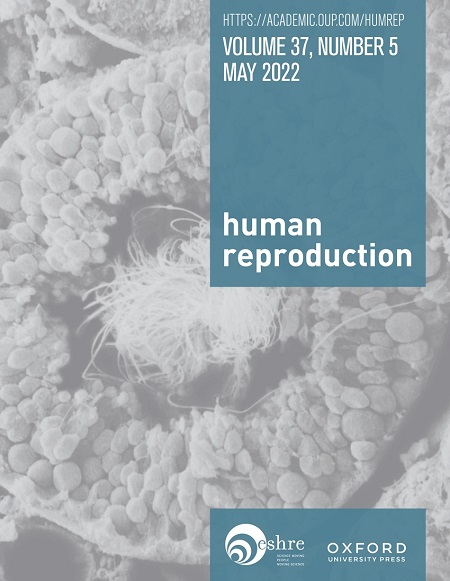In vitro system completely restores oogenesis in congenitally infertile mice.
IF 6.1
1区 医学
Q1 OBSTETRICS & GYNECOLOGY
引用次数: 0
Abstract
STUDY QUESTION Can in vitro systems, combined with transient gene expression or factor supplementation, completely restore fertility in congenitally infertile mice? SUMMARY ANSWER Transient expression of Kitl via adeno-associated virus (AAV) vectors or supplementation with recombinant KITL in KitlSl-t/KitlSl-t mice-a model of congenital infertility caused by a mutation in the Kitl locus-resulted in the production of mature oocytes and the birth of healthy, fertile offspring. WHAT IS KNOWN ALREADY Although in vivo gene delivery has enabled offspring production in infertile mouse models, low efficiency, unpredictability of parturition timing, inflammatory risk, possible viral genome integration, and lack of real-time oogenesis observation remain major concerns. Despite the potential of in vitro oogenesis as an alternative, complete functional restoration of gene deficiency has not been reported. STUDY DESIGN, SIZE, DURATION AAV-mCherry was applied to wild-type mouse ovaries, and expression levels were compared across 15 serotypes (2.5 × 1011 viral genomes/ml; N = 4-12; 4-day infection, 20-day culture) to identify optimal AAV serotypes for ovarian gene delivery. The effects of AAV-Kitl infection (six doses; N = 3-5) and recombinant KITL supplementation (four doses; N = 5) on oocyte growth were evaluated in KitlSl-t/KitlSl-t mouse ovaries. On culture day 17 or 18, secondary follicles were isolated and cultured for an additional 16 days to evaluate oocyte competence for maturation, fertilization, and full-term development. Offspring were delivered 52-53 days after treatment initiation. PARTICIPANTS/MATERIALS, SETTING, METHODS Ovaries from KitlSl-t/KitlSl-t mice were dissociated into single cells and reaggregated in U-bottom wells with media containing AAV8-Kitl, AAV9-Kitl, or recombinant KITL. Reconstituted ovaries were cultured on insert membranes, thereby allowing primordial follicles to develop into secondary follicles. Isolated secondary follicles were further cultured to the antral stage, and cumulus-oocyte complexes were subjected to IVM and IVF. The resulting embryos were transferred to foster mothers. Finally, the offspring were subjected to PCR screening for AAV sequences and fertility tests. MAIN RESULTS AND THE ROLE OF CHANCE AAV8, AAV9, AAVrh.10, and AAVrh.32.33 induced significantly higher levels of mCherry expression in wild-type mouse ovaries than 10 of the 15 AAV evaluated serotypes in vitro (P < 0.05). AAV8-Kitl promoted primordial follicle activation in a dose-dependent manner in KitlSl-t/KitlSl-t mouse ovaries, with the highest number of secondary follicles (80 per reconstituted ovary) obtained at 1.0 × 1011 vg/ml (P < 0.05). In contrast, AAV9-Kitl required 2.5- to 10-fold higher titers to achieve comparable levels of secondary follicle formation. Contrastingly, no secondary follicles were formed in KitlSl-t/KitlSl-t mouse ovaries following mock treatment. Furthermore, supplementation with 200 ng/ml recombinant KITL supported secondary follicle formation at levels comparable to those in the wild-type mouse ovaries. More than 10% of fertilized oocytes developed to full term, regardless of the treatment method. AAV DNA was not detected in the genomes of the 47 offspring, and all tested female mice exhibited normal fertility. LARGE SCALE DATA N/A. LIMITATIONS, REASONS FOR CAUTION To date, complete in vitro oogenesis has only been achieved in mice; its applicability to other species, including humans, remains unverified. WIDER IMPLICATIONS OF THE FINDINGS This study establishes a novel and controllable in vitro platform to compensate for gene function through transient gene expression or factor supplementation, without permanent genomic modification. This approach provides a powerful framework for the dissection of gene functions during oogenesis, modeling of reproductive disorders, and development of fertility restoration strategies in both clinical and conservation contexts. STUDY FUNDING/COMPETING INTEREST(S) This study was supported by KAKENHI (grant numbers 18H05547, 23K27088, and 25H01353). The authors declare no competing interests.体外系统完全恢复先天性不育小鼠的卵子生成。
体外系统,结合瞬时基因表达或因子补充,能否完全恢复先天性不育小鼠的生育能力?通过腺相关病毒(AAV)载体或补充重组Kitl在Kitl -t/Kitl -t小鼠(一种由Kitl基因座突变引起的先天性不孕症模型)中短暂表达Kitl,可产生成熟卵母细胞并产生健康、可育的后代。尽管在体内基因传递可以在不育小鼠模型中产生后代,但效率低、分娩时间不可预测、炎症风险、可能的病毒基因组整合以及缺乏实时的卵子发生观察仍然是主要问题。尽管体外卵发生作为一种替代方法具有潜力,但基因缺陷的完全功能恢复尚未报道。AAV- mcherry应用于野生型小鼠卵巢,比较15种血清型(2.5 × 1011个病毒基因组/ml; N = 4-12;感染4天,培养20天)的表达水平,以确定卵巢基因传递的最佳AAV血清型。在KitlSl-t/KitlSl-t小鼠卵巢中评估AAV-Kitl感染(6剂,N = 3-5)和重组KITL补充(4剂,N = 5)对卵母细胞生长的影响。在培养第17或18天,分离次级卵泡并再培养16天,以评估卵母细胞成熟、受精和足月发育的能力。幼崽在治疗开始后52-53天分娩。将kitsl -t/ kitsl -t小鼠的细胞分离成单细胞,并在含有AAV8-Kitl、AAV9-Kitl或重组KITL的培养基中在u型底孔中重新聚集。重建的卵巢在插入膜上培养,从而使原始卵泡发育为次生卵泡。分离的次级卵泡进一步培养到中央期,卵丘-卵母细胞复合物进行IVM和IVF。由此产生的胚胎被移植到养母身上。最后对子代进行AAV序列PCR筛选和育性检测。主要结果和作用的机会aav8, AAV9, AAVrh。AAVrh.32.33在体外诱导野生型小鼠卵巢中mCherry的表达水平显著高于15种AAV血清型中的10种(P < 0.05)。AAV8-Kitl在kitls -t/ kitls -t小鼠卵巢中促进原始卵泡激活呈剂量依赖性,在1.0 × 1011 vg/ml时获得的次级卵泡数量最多(80个/个)(P < 0.05)。相比之下,AAV9-Kitl需要2.5至10倍的高滴度才能达到相当水平的继发性卵泡形成。相比之下,KitlSl-t/KitlSl-t小鼠卵巢在模拟处理后未形成继发卵泡。此外,补充200 ng/ml重组KITL支持次级卵泡形成,其水平与野生型小鼠卵巢相当。不管采用何种治疗方法,超过10%的受精卵发育到足月。在47只后代的基因组中未检测到AAV DNA,所有被测试的雌性小鼠均表现出正常的生育能力。大规模数据采集。迄今为止,完全的体外卵子生成仅在小鼠中实现;它对包括人类在内的其他物种的适用性仍未得到证实。这项研究建立了一个新的、可控的体外平台,通过短暂的基因表达或因子补充来补偿基因功能,而不需要永久性的基因组修饰。该方法为卵子发生过程中基因功能的解剖、生殖障碍的建模以及临床和保护背景下生育恢复策略的发展提供了强大的框架。研究经费/竞争利益(S)本研究由KAKENHI(资助号18H05547, 23K27088和25H01353)支持。作者声明没有利益冲突。
本文章由计算机程序翻译,如有差异,请以英文原文为准。
求助全文
约1分钟内获得全文
求助全文
来源期刊

Human reproduction
医学-妇产科学
CiteScore
10.90
自引率
6.60%
发文量
1369
审稿时长
1 months
期刊介绍:
Human Reproduction features full-length, peer-reviewed papers reporting original research, concise clinical case reports, as well as opinions and debates on topical issues.
Papers published cover the clinical science and medical aspects of reproductive physiology, pathology and endocrinology; including andrology, gonad function, gametogenesis, fertilization, embryo development, implantation, early pregnancy, genetics, genetic diagnosis, oncology, infectious disease, surgery, contraception, infertility treatment, psychology, ethics and social issues.
 求助内容:
求助内容: 应助结果提醒方式:
应助结果提醒方式:


